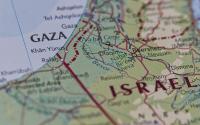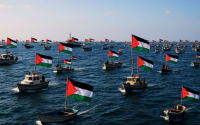Independent, 22 October 2001
After Osama, "Godfather of Terror'' – our very own cliché – comes Osama, "Saviour of the Muslim World'', Osama, the "New Saladin'', Osama "V Mahdi''. Amid the blue moped fumes of the Peshawar bazaar, his face beams out of a hundred bookshops, turbaned, wise, half-smiling, disembodied.
On the front cover of Khaled Choudhury's Osama bin Laden: Freedom Fighter or Terrorist? – readers may guess which conclusion the author draws – Mr bin Laden gazes down at us from the sky above the snows of the Afghan mountains. Printed by Shaheed Publishers (shaheed means martyr) Choudhury's slim, hard-cover volume is dedicated "to all Islamic Fighters''.
But let's be fair. Only a month ago, the photo-editors of Time magazine asked to buy for a possible front cover one of my snapshots of Mr bin Laden – which I took in one of his desert camps in Afghanistan in 1996 – and then announced that they intended to "age" the photo digitally to make the world's bete noir look older. I told Time to go jump in the lake. No photo. But few lakes are deep enough for the white T-shirt currently hanging in the bazaars here. "Jihad is our mission," says one, beneath Mr bin Laden's face, followed by the quotation, "As a Muslim, it is my aim to spread Islam throughout the world by love or power". Another exhorts the wearer to remember that Osama "is a Muslim brother – Osama is one of us".
Western journalists will no doubt be sending this little keepsake to their editors; in the days of the Iranian revolution, most of us bought watches illustrated with Ayatollah Khomeini's face in which the minute hand was composed of a splodge of martyr's blood. But we should not mock the purpose, or possible result, of this hero worship in the souks of Pakistan. Reading Choudhury's work, you can see why men and women here regard Mr bin Laden as a just and good man, persecuted by the United States not because he blows up buildings but because he defies the greatest power on Earth. The Americans may have the most sophisticated military equipment, the author says, but Mr bin Laden proves they don't have faith in God.
Tareq Ismael Sagar's Osama bin Laden: One Man, One Movement, begins in fairy-tale style. "On a cold evening in December, 1997,'' Sagar writes, "a handsome young Arab sits in his room, thinking about what he can do for the world ... his father advised him to go to Afghanistan." Forget that Mr bin Laden was already in Afghanistan by 1997 and that it was a senior member of the Saudi intelligence service who originally asked him to go there – not Mr bin Laden senior. Sagar's hero worship knows no bounds. He wishes "love to Osama'' and praises his military and economic assistance to Bosnia, Chechnya, Sudan ...
But who can blame Muslims for being obsessed with Mr bin Laden when the West has been equally obsessed with him for years? Choudhury proudly tells us that his book has entered its second edition "by public demand'', and I can believe it. Sagar's work informs readers that its English distributors are Green Dome International Limited, operating from 148-164 Gregory Boulevard, Nottingham, NG7 5JC. "Every Muslim,'' Sagar says, "must get to know their new leader, especially young people ... Saddam Hussein never had our support, but Osama does.''
If Choudhury lays on the jam – Mr bin Laden is "majestic'' and "legendary'' – he deals in a now-familiar style with the World Trade Centre attacks. Assaults on America had hitherto only happened outside the United States: in Dar es Salaam, Nairobi, Aden and Al-Khobar (in Saudi Arabia). So the World Trade Centre destruction, of which there is a powerful graphic in the volume, was obviously the work of the CIA and Mossad. And there follow the now familiar questions about the supposedly "missing'' 4,000 Israelis who did not go to work in the buildings on 11 September. There is no reference to the Jewish Americans slaughtered.
Sagar includes an intriguing account of one of Mr bin Laden's "hiding places'', a system of caves in Logar province, which the author says he visited. "I saw three places there ... three rooms; one was a library, the second contained sophisticated communications technology. But the third contained just a single Kalashnikov rifle, which bin Laden had taken from a Russian officer whom he had killed in the war against the Soviets.''
Some of the texts are a little confusing. One goes to great lengths to deny the (hitherto unheard) argument that Mr bin Laden killed a close Palestinian friend, Abdullah Azzam – blown up by a car bomb in Peshawar – while others carry quotations Mr bin Laden has allegedly given in interviews with Arab journalists. The destruction of America, he reportedly says, "is in my hands''. After the Clinton flurry of cruise missiles at his camps after the bombings of American embassies in Africa, Mr bin Laden is quoted as promising that "my war has not started yet – I believe in action, not words'', which might have come straight from a speech by George Bush or, indeed, by Ariel Sharon.
There is an element of fantasy. Choudhury insists that Mr bin Laden thinks in "threes". Thus we are told the most important elements in his life are trust in God, fighting for God and fighting for a Muslim's rights. Thus his three favourite places are the mosques of Mecca, Medina and Jerusalem. His three most hated countries – in decreasing order of importance, of course – are the United States, Israel and Russia.
But all is not lost. The American journalist John Cooley's Unholy Wars has pride of place in several bookshops.
And lunatics who demand the withdrawal of any book that dares to praise Mr bin Laden can rest assured that another personality is well represented among the book stacks of Peshawar. I don't know why, but Pakistanis seem obsessed with a man some regard as responsible for more deaths than Mr bin Laden. A certain Henry Kissinger.






